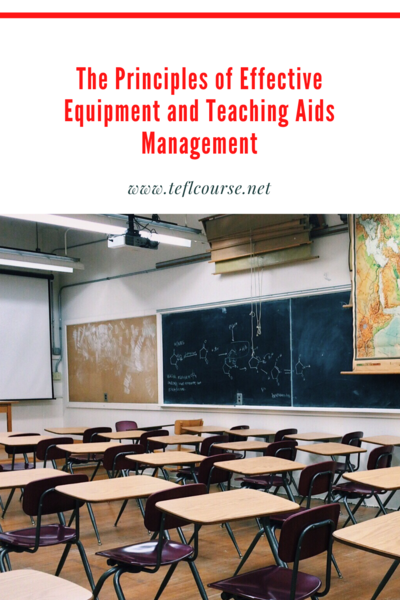The Principles of Effective Equipment and Teaching Aids Management

One of the most useful decisions that a teacher can make is the choice to know his or her limitations. Realizing one's shortcomings does not excuse an instructor from conveying the lesson. Instead, this determination means that a teacher needs to employ supporting tools to help reach the students. One such possibility is the use of teaching aids.
Table of Contents
Do you want to teach English abroad? Take a TEFL course!
This post was written by our TEFL certification graduate Derek G. Please note that this blog post might not necessarily represent the beliefs or opinions of ITTT.
Teaching aids can provide an educator with an active choice for classroom lecturing. When used correctly, an instructor can use teaching aids to stimulate, engage, and develop a lesson plan in a way that he or she might not be able to do otherwise. Over the next several pages, I will discuss two different types of teaching aids. I will discuss their strengths, weaknesses, and how I can see using them in a class of my own.
Merriam-Webster's online dictionary (2019) defines a "Teaching aid" as "an object (such as a book, picture, or map) or device (such as a DVD or computer) used by a teacher to enhance or enliven classroom instruction. In Merriam-Webster's definition, I do not think the types of aids are as important as is their outcome. For any of us who have engaged in formal education, we know that, at times, we struggle to remain engrossed, present, or stimulated. As a result, teaching aids are available to do what Meriam-Webster said, "…to enhance or enliven classroom instruction."
Also Read: How do I choose a TEFL course?
Video Learning
One of the most common teaching aids is the use of video or film. However, despite their usefulness, they do have pitfalls that teachers need to see as well. Brainscape (2017) cited the portability, the impact a visual aid can bring to a lesson, and the flexibility of reviewing the video, as just a few of the positives a visual aid can bring to a classroom. However, Brainscape also mentioned the fact that videos can be challenging to use and edit, and the need for and maintenance of equipment, as being a couple of the drawbacks to using visual aids in the classroom.
Of all the issues surrounding the use of videos in class, I think the set-up, maintenance, and actual use of video equipment might be their biggest challenge. Teachers may not always be technologically savvy. Although they make our lives much more manageable, devices like computers can also be temperamental and unpredictable.
Personally speaking, I have used video aids when lecturing as a student. I found videos to be an irreplaceable tool for sending a message that I could not convey with words alone. For example, while earning my degree in Forensic Psychology, nothing showed the accurate presentation of a disorder than a short video clip of someone suffering from the condition.
Also read: Top Online Lesson Plan Resources for New and Advanced Teachers
Worksheets
The second type of teaching I will discuss is one that instructors have used for generations, the worksheet. Worksheets usually come in the form of a sheet of paper or nowadays, an editable document that the teacher provides, and that student complete alone or in a group.
A significant reason that worksheets are so common is that they have several positive aspects. Anna G from the website, "The Measured Mom" (2014), which is a site dedicated to teaching listed one the most positive aspects of worksheets are, at times, a worksheet might be the only method of teaching a lesson. With certain subjects such as math or learning a new language, a worksheet might be one of the only ways a student can solve an equation or practice writing a newly discovered word.

However, as with visual aids, worksheets have concerns, as well. The Measured Mom (2014) listed a few concerns with them as being, that they since they supply much of the needed information, worksheets do not enable a student to practice a "higher level of thinking." Additionally, because many teachers use pre-created worksheets, the teacher is not examining the exact needs of a specific class.
Also read: Getting Student Placement Right - The Best Desk Arrangements for EFL Students
One aspect of worksheets that can be both a blessing and a curse is the reproduction of them. Using paper worksheets can supply an uncomplicated way of creating an easy to distribute teaching tool. With the creation of one document, a copier, and a stack of paper, a teacher can have enough worksheets for an entire class in just minutes. However, when a machine fails to work correctly, a teacher does not make enough copies, or unexpected students arrive, problems are bound to occur.
Do you want to teach English abroad? Take a TEFL course!
I think that worksheets have a place in the classroom. I certainly would not want to be the kind of teacher who allows a worksheet to teach a class for me. However, I can see how using a worksheet can supplement a lesson plan nicely.
Video aids and worksheets are remarkably different tools. However, as we have discussed, both have a place in a classroom. Neither is perfect nor should serve as a teacher's primary method for teaching. Nonetheless, both can serve as useful teaching aids to supplement a teacher's lesson plan.
Apply now & get certified to teach english abroad!
Speak with an ITTT advisor today to put together your personal plan for teaching English abroad.
Send us an email or call us toll-free at 1-800-490-0531 to speak with an ITTT advisor today.
Related Articles:
- How do I get a job teaching English in South Korea
- 10 Questions You Need to Ask Before Enrolling In a TEFL Course
- The 10 Best Destinations for Teaching English Abroad in 2018
- Online or In-Class - Which TEFL Course Should You Take?
- The Best Government Programs For Teaching English Abroad
- What Scams to Look Out for When Looking for TEFL Jobs




